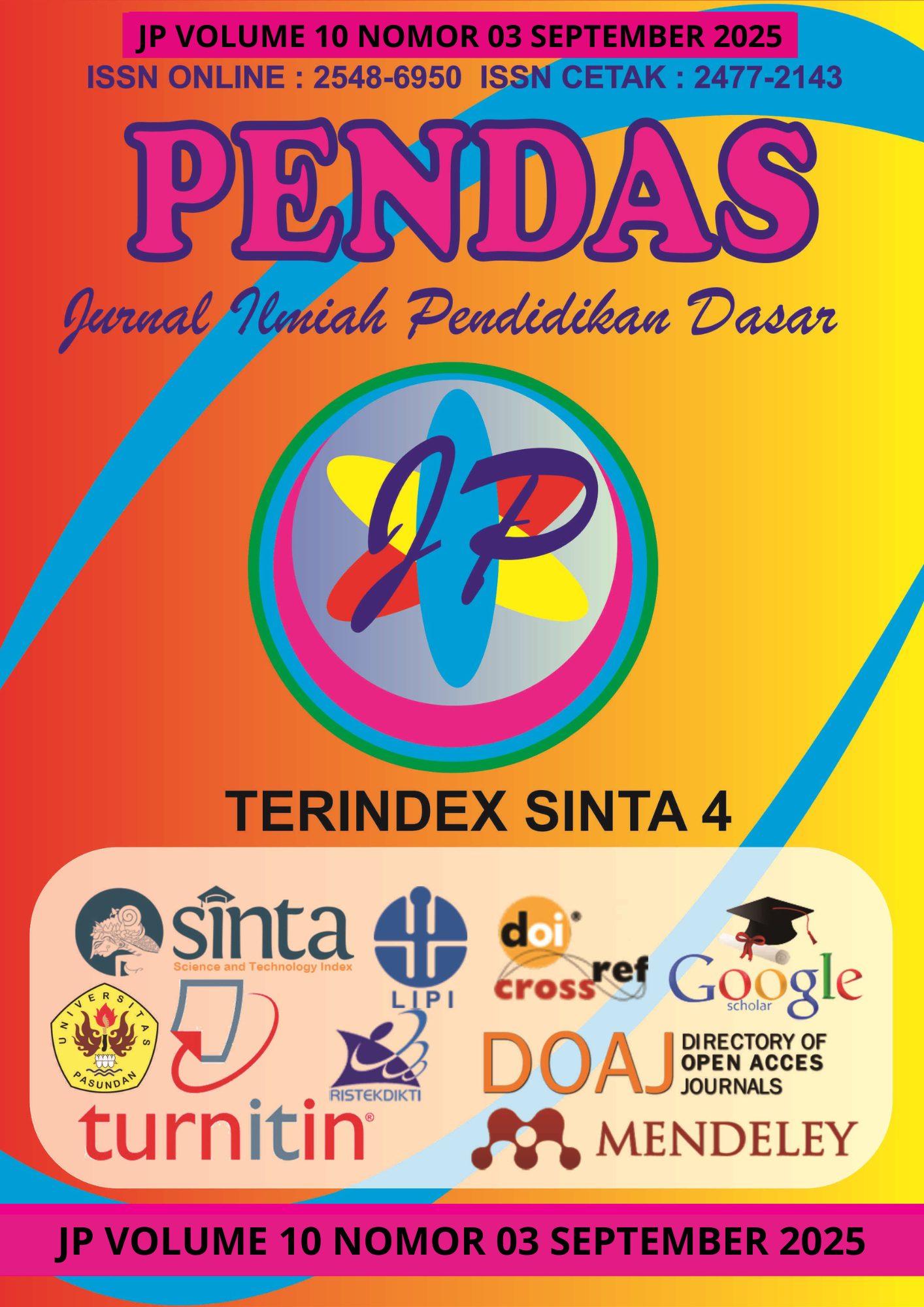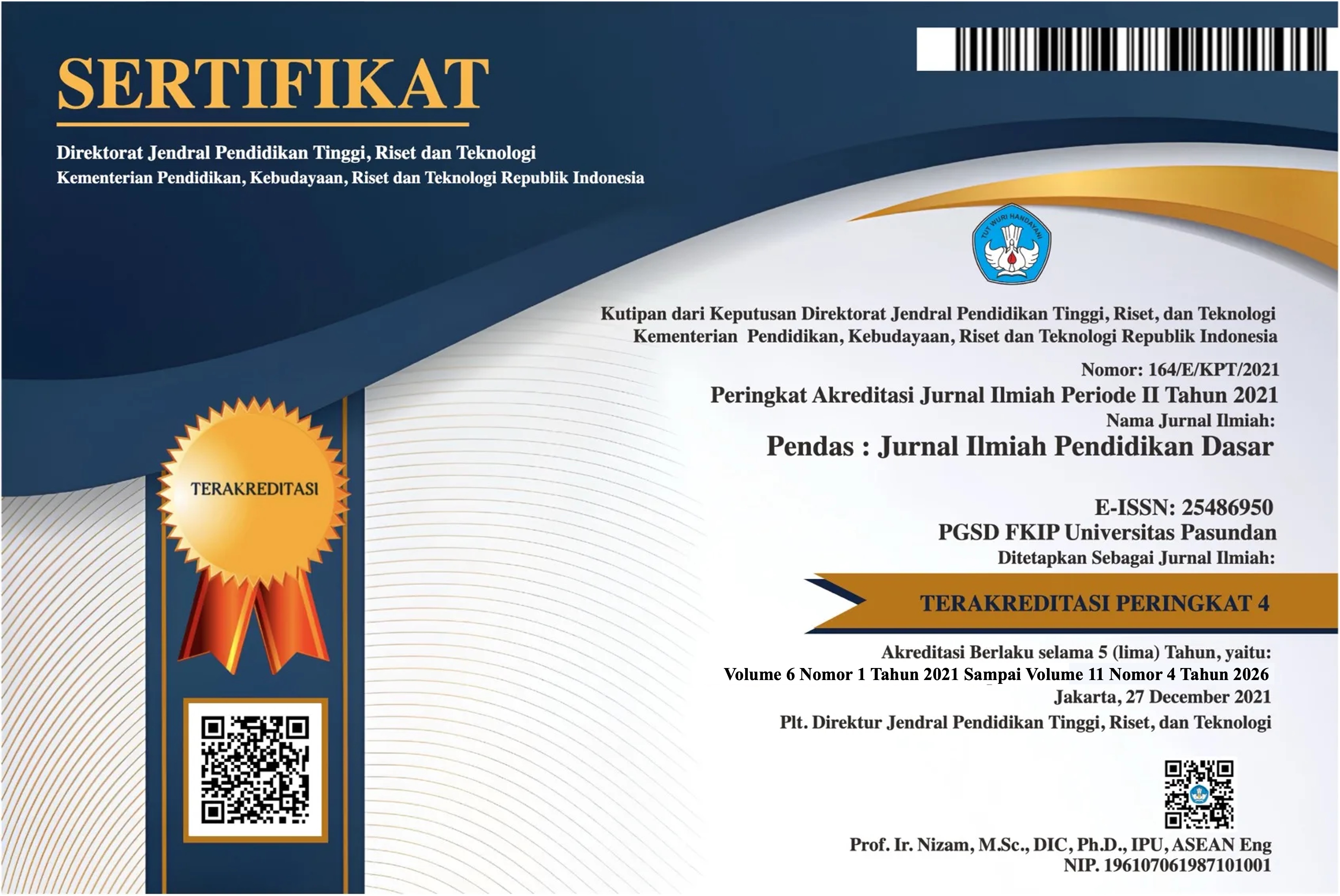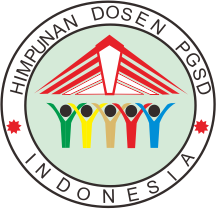EFEKTIVITAS DESAIN BERBASIS MODEL PEMBELAJARAN INQUIRY DENGAN PENDEKATAN REALISTIC MATHEMATICS EDUCATION (RME) DALAM MENINGKATKAN KEMAMPUAN BERPIKIR KRITIS
DOI:
https://doi.org/10.23969/jp.v10i3.28601Keywords:
learning design, critical thinking skills, RME approach, inquiry learningAbstract
This study aims to determine the effectiveness of inquiry-based learning model design with a realistic approach to improve students' critical thinking skills. The learning design was developed using the Borg and Gall design consisting of 10 development steps. The sample in this study were students of class IVA and IVB SDN 55 Gedong Tataan Pesawaran totaling 26 students in each class. Class IVA as the experimental class and class IVB as the control class. The results of the N-Gain test conducted obtained a value of 0.64 in the experimental class with a moderate category and 0.42 in the control class with a moderate category. The results of the independent sample t-test conducted by comparing the pretest values of the experimental and control classes obtained a sig. value of 0.236> 0.05, which means H0 is rejected so that it can be concluded that there is no significant difference in the pretest values of the experimental and control classes. The test results on the posttest value obtained a sig. value of 0.001<0.05, which means H1 is accepted so that it can be concluded that there is a significant difference between the average values of the experimental and control classes
Downloads
References
Afifah, R. N., Oktaviya, U., Qoriroh, R., & Wahyuni, I. W. (2023). Analisis Kemampuan Berpikir Kritis Dalam Menyelesaikan Soal Cerita Berdasarkan Kemampuan Matematika Siswa. Laplace : Jurnal Pendidikan Matematika, 6(1), 207–216. https://doi.org/10.31537/laplace.v6i1.1121
Andriani, W., Siswono, T. Y. E., & Prastiti, T. D. (2023). Pengembangan E-Book Bangun Datar untuk Meningkatkan Kemampuan Berpikir Kritis Siswa Kelas III Sekolah Dasar. MAJAMATH: Jurnal Matematika Dan Pendidikan Matematika, 6(1), 33–47. https://doi.org/10.36815/majamath.v6i1.2544
Anggraeni, R. (2017). Pengaruh Model Pembelajaran terhadap Peningkatan Kemampuan Kognitif Siswa. Jurnal Pendidikan, 12(1), 85-95.
Asrori, I. 2013. Pengembangan Desain Pembelajaran Teknologi Pendidikan Islam. Seminar Teknologi Pendidikan Islam. Tulung Agung: STAIN Tulung Agung Prastowo, Andi. (2019). Panduan Kreatif Membuat Bahan Ajar Inovatif. Diva Press, Yogyakarta
Astutik, P., & Hariyati, N. (2021). Peran Guru dan Strategi Pembelajaran Dalam Penerapan Keterampilan Abad 21 Pada Pendidikan Dasar Dan Menengah. Jurnal Inspirasi Manajemen Pendidikan, 9(3), 621.
Cohen, J. (1988). Statistical Power Analysis for the Behavioral Sciences. Lawrence Erlbaum Associates.
Creswell, J. W. (2014). Research Design: Qualitative, Quantitative, and Mixed Methods Approaches. SAGE Publications.
Dewey, J. (1933). How We Think. D.C. Heath & Co.
Dewey, J. (1938). Experience and Education.
Dores, O. J., Wibowo, D. C., & Susanti, S. (2020). Analisis Kemampuan Berpikir Kritis Siswa Pada Mata Pelajaran Matematika. J-PiMat : Jurnal Pendidikan Matematika, 2(2), 242–254. https://doi.org/10.31932/j-pimat.v2i2.889
Feldman, A. (2005). Improving Student Learning through Educational Interventions. Journal of Education, 40(2), 112-119.
Field, A. (2013). Discovering Statistics Using IBM SPSS Statistics. SAGE Publications.
Freudenthal, H. (1991). Revisiting Mathematics Education: China Lectures. Kluwer.
Gravemeijer, K. (1994). Developing Realistic Mathematics Education. Utrecht: Freudenthal Institute
Hafild, M. N. R., & Yulianti, D. (2025). Meningkatkan kemampuan komputasi siswa dengan model pembelajaran berbasis STEAM-PJBL. Pendas: Jurnal Ilmiah Pendidikan Dasar, 10(01), 422-432. https://doi.org/10.23969/jp.v10i01.20525
Hake, R. R. (1998). Interactive Engagement vs. Traditional Methods: A Six-Thousand-Student Survey of Mechanics Test Data for Introductory Physics Courses. American Journal of Physics, 66(1), 64-74.
Handayani, S., Caswita, C., & Nurhanurawati, N. (2020). Pengembangan Desain Pembelajaran Berbasis Penemuan Terbimbing Untuk Meningkatkan Kemampuan Berpikir Kritis Matematis. Jurnal Cendekia : Jurnal Pendidikan Matematika, 4(2), 1098–1105. https://doi.org/10.31004/cendekia.v4i2.344
Hinkle, D. E., Wiersma, W., & Jurs, S. G. (2003). Applied Statistics for the Behavioral Sciences. Houghton Mifflin.
Jonassen, D. H. (2000). Computers as Mindtools for Schools: Engaging Critical Thinking. Merrill/Prentice Hall.
Keller, G. & Bickman, L. (2004). Research Methods in Education: A Practical Guide. SAGE Publications.
King, F.J., Goodson, L., M.S., dan Rohani, F., 2010, Higher Order Thinking Skills. Assessment dan Evaluation Educational Service Program.
Levenson, E. (2021). Critical Thinking in Realistic Mathematics Education: A Classroom Study. International Journal of Science and Mathematics Education, 19(2), 101–115.
Lipman, M. (2003). Thinking in Education. Cambridge University Press
Macmillan Bruner, J. (1961). The Act of Discovery. Harvard Educational Review.
Miller, J. B. (2012). Statistics for Business and Economics. Pearson Education.
Nurhidayati, S., Thamrin, T., & Baharuddin, A. (2017). Pengembangan Bahan Ajar Berbasis Masalah Untuk Memfasilitasi Pencapaian Kemampuan Penalaran Pada Pokok Bahasan Perbandingan Kelas VII MTSN Model Makassar. Jurnal MaPan (Jurnal matematika dan Pendidikan) Vol. 5, No. 2. (http://journal.uin-alauddin.ac.id/index.php/Mapan/article/view/3530/pdf)
Nursyamsi, A., Suwondo, S., & Zulfarina, Z. (2021). Penggunaan Model Inkuiri Terbimbing (Guided Inquiry) Terintegrasi Mind Mapping untuk Meningkatkan Kemampuan Berpikir Kritis dan Hasil Belajar Siswa dalam …. Jurnal Pendidikan Tambusai, 5, 6295–6304. https://jptam.org/index.php/jptam/article/view/1374%0Ahttps://jptam.org/index.php/jptam/article/download/1374/1719
Pallant, J. (2020). SPSS Survival Manual: A Step by Step Guide to Data Analysis Using IBM SPSS. McGraw-Hill Education.
Pallant, J. (2020). SPSS Survival Manual: A Step by Step Guide to Data Analysis Using IBM SPSS. McGraw-Hill Education.
Piaget, J. (1950). The Psychology of Intelligence. Routledge.
Prahmana, R.C.I. et al. (2022). Inquiry-Based RME: Improving Critical Thinking in Indonesian Elementary Schools. Journal on Mathematics Education, 13(1), 1–18.
Rahayu, C., Setiani, W. R., Yulindra, D., & Azzahra, L. (2025). Pendidikan Matematika Realistik Indonesia dalam Pembelajaran Mendalam (Deep Learning): Tinjauan Literatur. Jurnal Pendidikan Matematika Universitas Lampung, 13(1), 9-25.
Reigeluth, C. M. (2013). Instructional-design Theories and Models: An Overview of Their Current Status. Lawrence Erlbaum Associates.
Sagala, S. (2011). Konsep dan Makna Pembelajaran. Bandung: Alfabeta
Schraw, G. (2010). Promoting General Metacognitive Awareness. Instructional Science, 38(1), 1-15.
Sitorus, F. D., Hasratuddin, H., & Azhar, E. (2024). Pengembangan LKPD Berbasis Hots Melalui CTL untuk Meningkatkan Kemampuan Berpikir Kritis dan Penalaran Matematis Peserta Didik. JIIP - Jurnal Ilmiah Ilmu Pendidikan, 7(4), 3695–3701. https://doi.org/10.54371/jiip.v7i4.4297
Surya, E., Putri, F. A., & Mukhtar. (2020). Metacognitive development through RME-inquiry approach in elementary mathematics. European Journal of Educational Research, 9(1), 65-78.
Topping, K. J. (2011). Peer Assisted Learning: A Framework for Consultation and Professional Development. International Journal of Educational Psychology, 6(2), 205-225.
Treffers, A. (1987). Three Dimensions: A Model of Goal and Theory Description in Mathematics Education. Reidel.
Van den Heuvel-Panhuizen, M. (2019). Revisiting realistic mathematics education: New evidence on critical thinking. Freudenthal Institute.
Vygotsky, L. (1978). Mind in Society. Harvard University Press.
Wona, L. M., Pare, M. I., Deme, C. M., Io, A., Itu, A., & Lawe, Y. U. (2023). Peningkatan Kemampuan Berpikir Kritis Siswa Kelas 3 Sd Pada Pembelajaran Ipa Melalui Metode Diskusi. Jurnal Citra Pendidikan Anak, 2(1), 24–35. https://doi.org/10.38048/jcpa.v2i1.1524
Downloads
Published
Issue
Section
License
Copyright (c) 2025 Pendas : Jurnal Ilmiah Pendidikan Dasar

This work is licensed under a Creative Commons Attribution 4.0 International License.



















